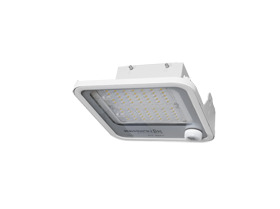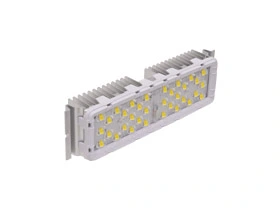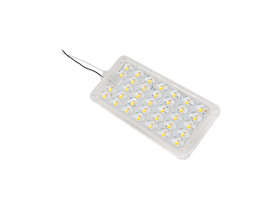LED Street Light Head Light Distribution Requirements and Solution Analysis
The light distribution of LED street light head is to make the light project as far as possible to all areas of the illuminated road to obtain a light distribution that meets the requirements of road lighting. Whether the light distribution design of LED street light head is accurate or not is one of the key factors for whether it can replace traditional street lamps.
Ⅰ. Characteristics and requirements of light distribution of LED street light head
1. Light distribution shape characteristics of LED street light head
In road lighting, if there is no light distribution for the light source of the LED street light head, the light pattern irradiated on the road surface is a large circular spot, and part of the light will be scattered outside the road surface and not used.
In order to meet the requirements for the brightness, illuminance and uniformity of the road surface, and to distribute most of the light on the road surface as much as possible to improve the utilization rate of the light and reduce waste, it is usually necessary to distribute the light of the LED street light head. The light pattern or spot formed by the output light irradiating on the road surface is preferably a rectangle.
2. Light distribution curve of LED street light head
The spatial distribution of luminous intensity is often referred to as a light distribution curve. Below the street light, the light intensity should be the smallest, and as the elevation angle θ increases, the light intensity I increases.
Due to the complexity of optical design, it is difficult for the light distribution shape to fully conform to the functional relationship. The projection range of the θ angle can be reduced and the spacing of lamps can be reduced to obtain uniform illuminance.
Generally speaking, it is hoped that a wide-angle "batwing"-shaped light distribution can be achieved after light distribution.
Ⅱ. Light distribution scheme and analysis of LED street light head
The light distribution scheme of the LED street light head is carried out on the basis of the road lighting requirements, and at the same time, it is necessary to consider the control of glare and the environmental factor. For road lighting, light efficiency and light distribution curve are two important parameters. At present, the light distribution scheme of LED street light head mainly has the following basic forms.
1. Primary light distribution of LED street light head
In the manufacturing process of power LEDs, the use of lens technology during packaging can improve light efficiency, reduce light output loss, and change light output characteristics. The LED packaging lens technology has a certain relationship with the primary light distribution of high-power LED street lights. Through a good design of the encapsulation lens, the LED can obtain better light output characteristics.
The LED light distribution packaged by the double-headed lens can transform the light intensity output curve of a single LED into a "batwing" shape, so as to further realize the "batwing" shape light distribution of the overall light intensity output curve of the entire street lamp.
2. Secondary light distribution of LED street light head
Using a lens or a reflector to further change the output light characteristics of the high-power LED in the LED street light head is the secondary light distribution of the LED street light head.
The secondary light distribution of LED street light head mainly includes the following situations:
LED secondary light distribution with total reflection lens. Light is emitted from a relatively dense medium to a relatively thin medium. When the incident angle is greater than the critical angle, total reflection can occur. Using this principle, an axisymmetric total reflection lens is designed. For example, changing the beam angle to a range of ±30° is beneficial to further light distribution design.
LED secondary light distribution using free-form lens. In this design, a free-form surface optical element with asymmetric rectangular light distribution in the XY axis direction is used. For example, a uniform distribution of light of ±60° is generated on the X axis to meet the lighting requirements of the length direction of the road. The light distribution of ±30° uniform distribution is generated on the Y axis, and the LED "batwing" shape light distribution with rectangular lighting effect is obtained.
The free-form surface design includes the differential equation method, the multi-parameter optimization method, the multi-surface simultaneous design method and the shearing method to obtain the matching of the light distribution of the light source and the light distribution of the illumination target surface.
LED secondary light distribution with external lens and reflector. Select the appropriate lens and parabolic reflector to make the outgoing light meet certain requirements.
3. Three light distribution of LED street light head
The tertiary light distribution of the LED street light head is based on the completion of the primary and secondary light distribution of high-power LEDs, and is realized by superimposing and spatially arranging multiple LEDs (unit modules) to meet the requirements of average brightness, average illuminance and uniformity of road lighting.
 English
English  العربية
العربية  中文
中文
 Deutsch
Deutsch
 Türkçe
Türkçe

 日本語
日本語


